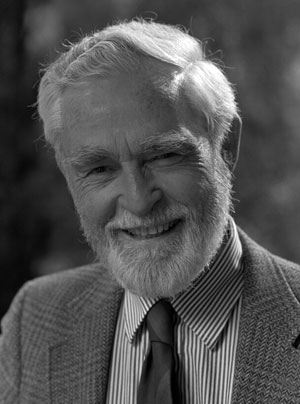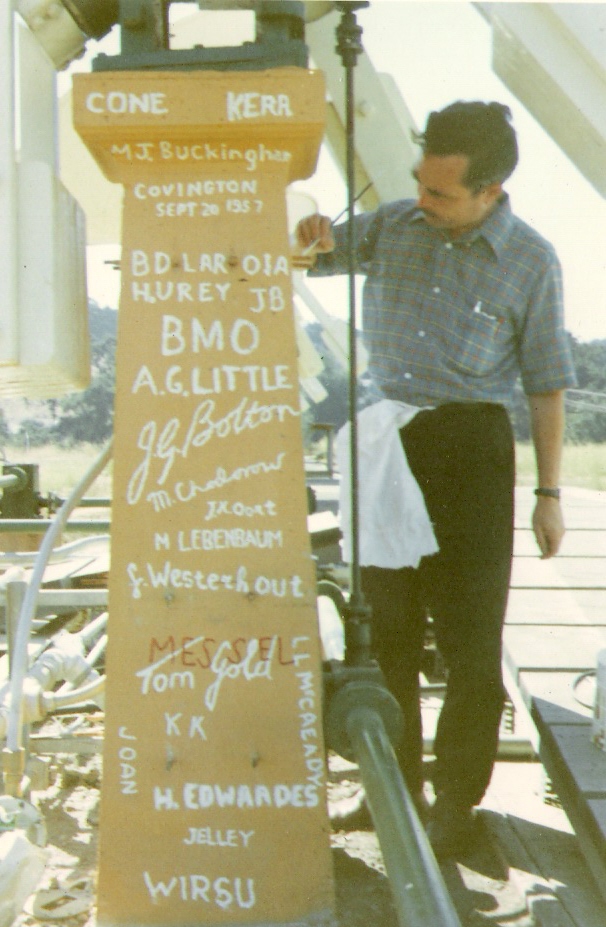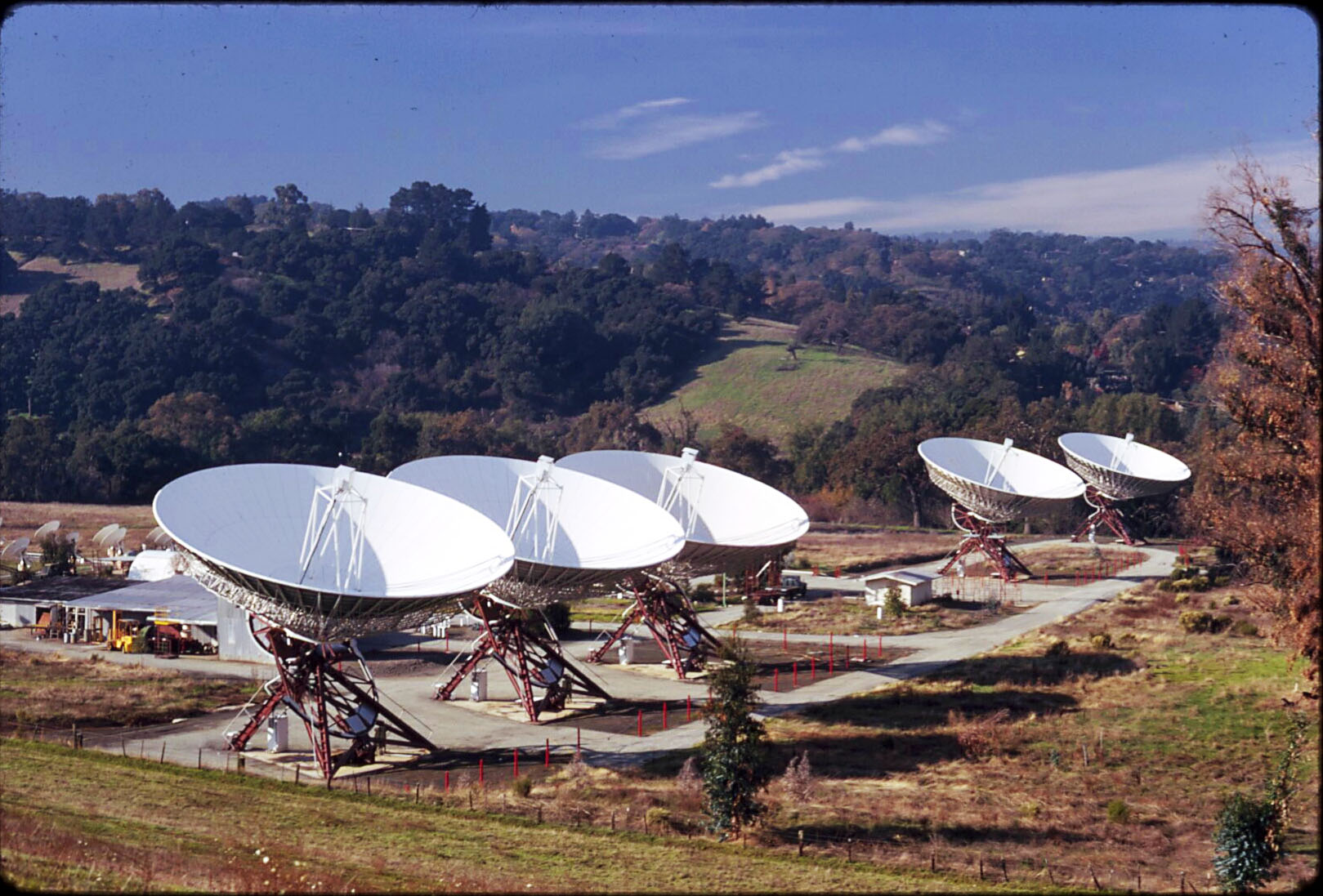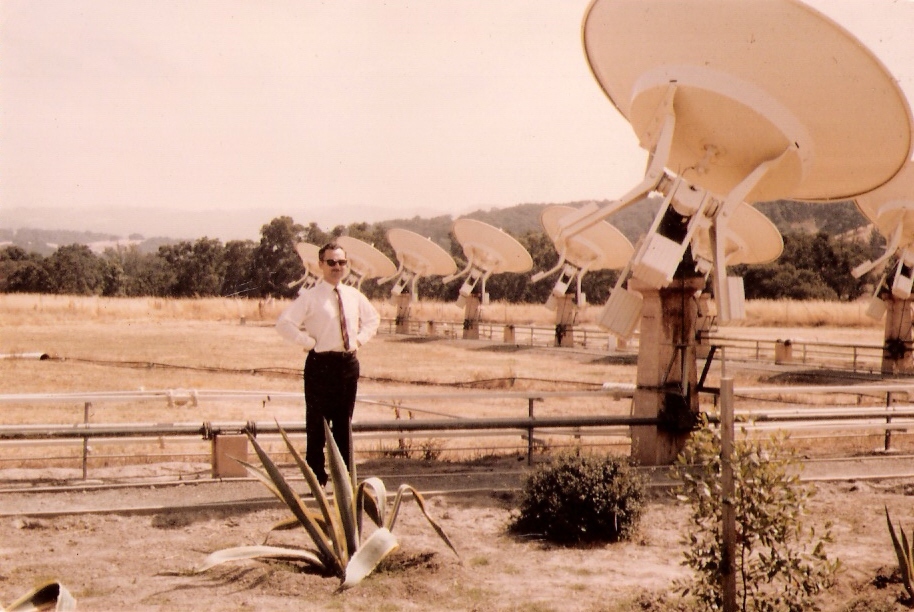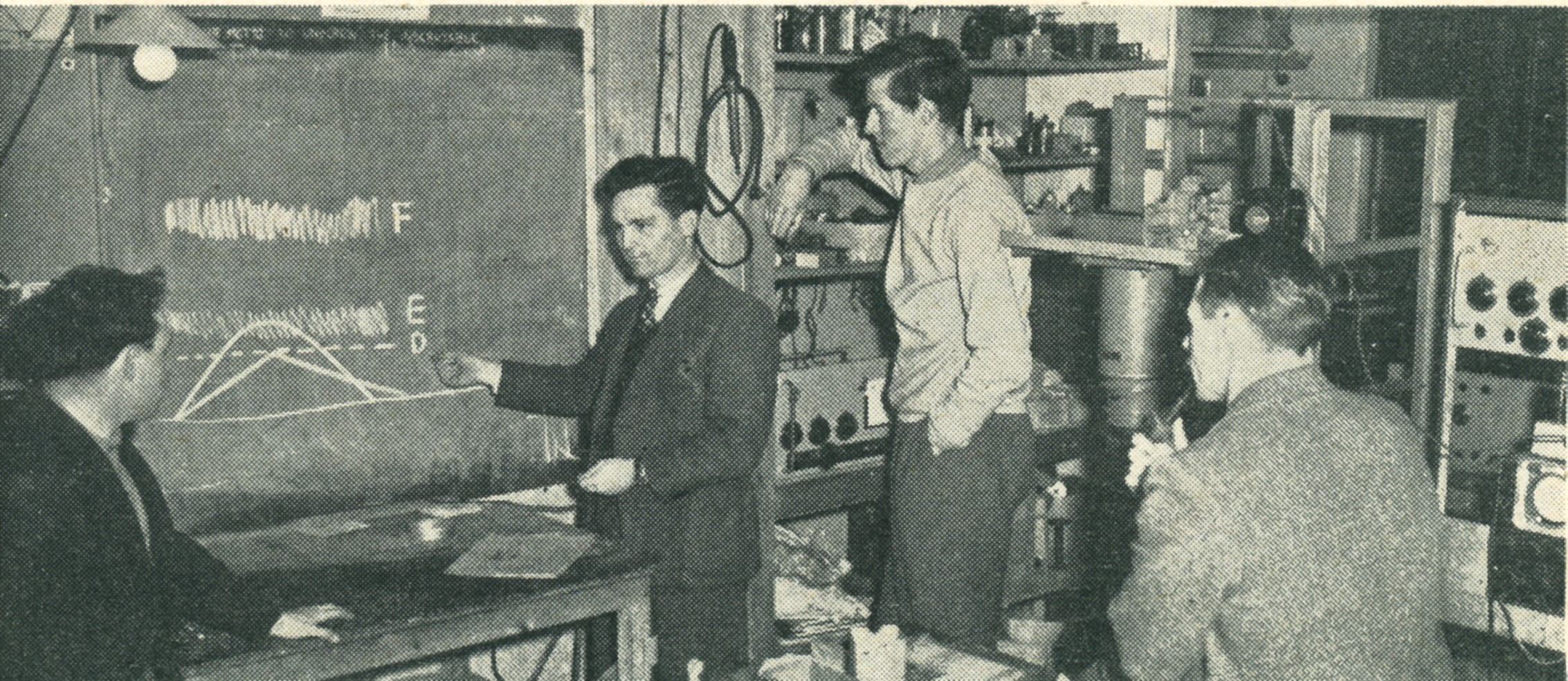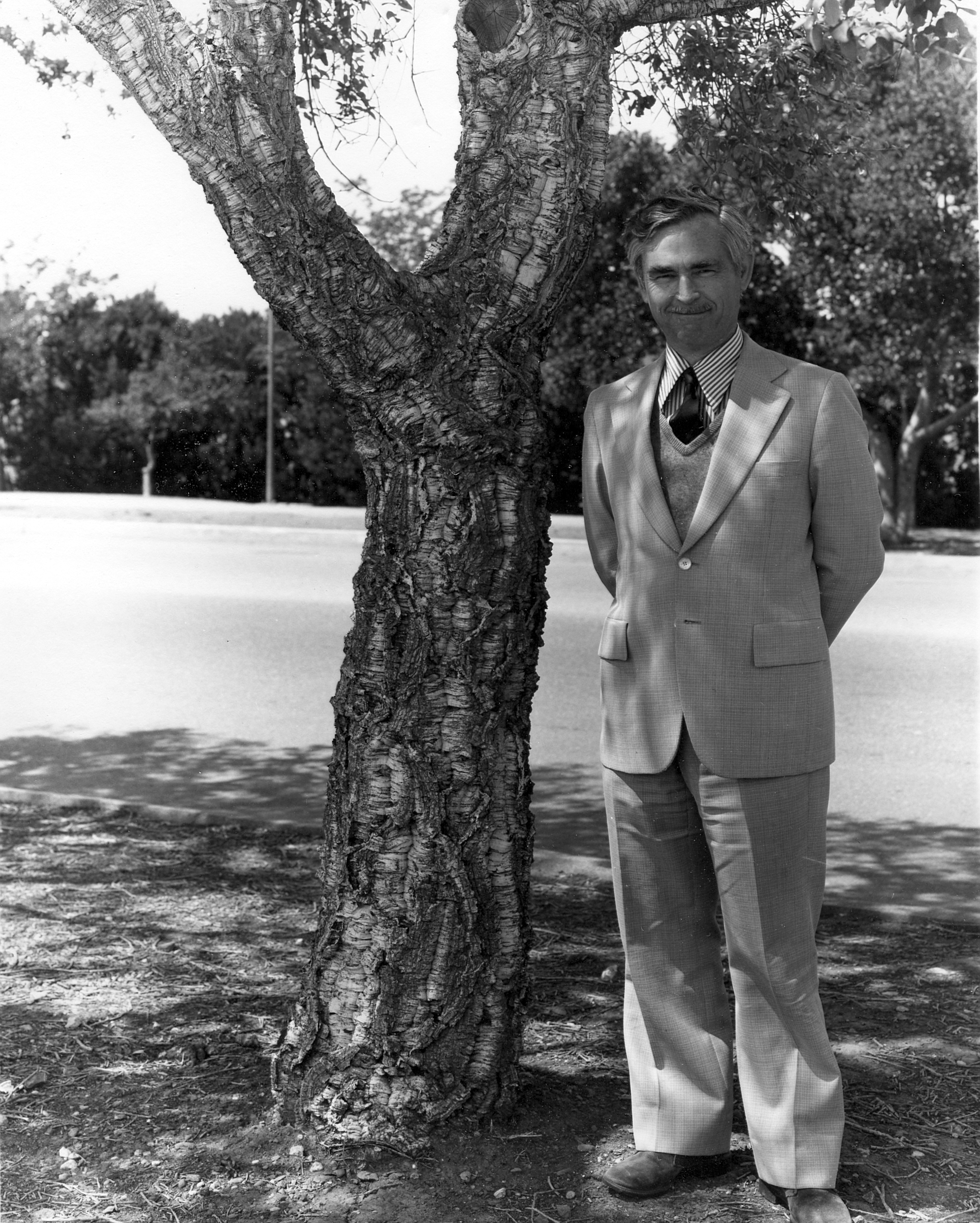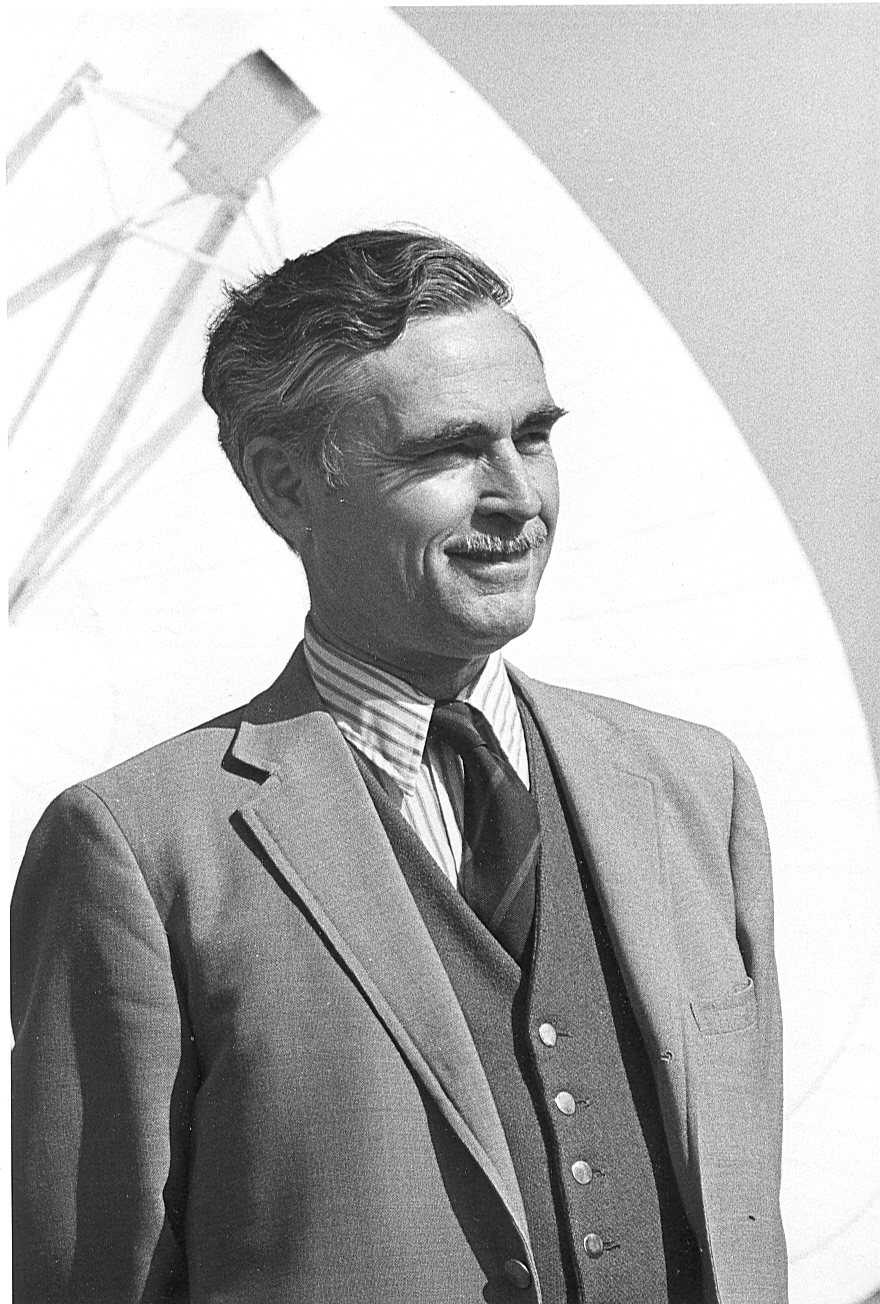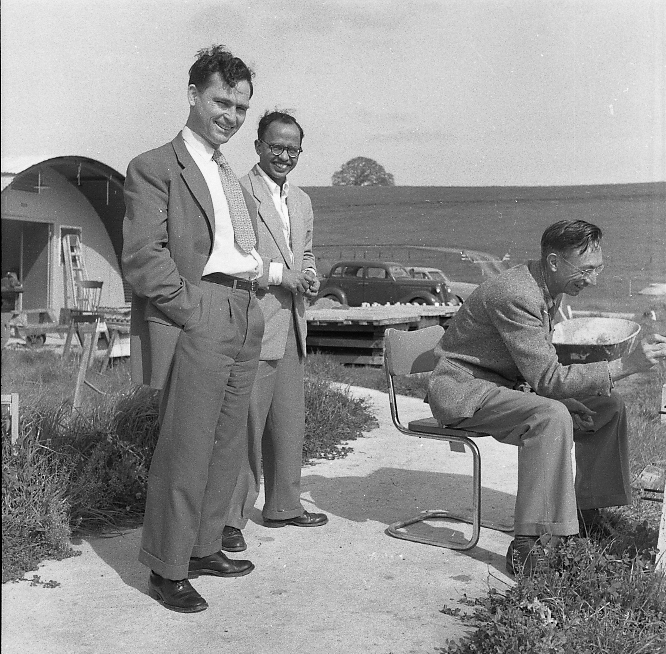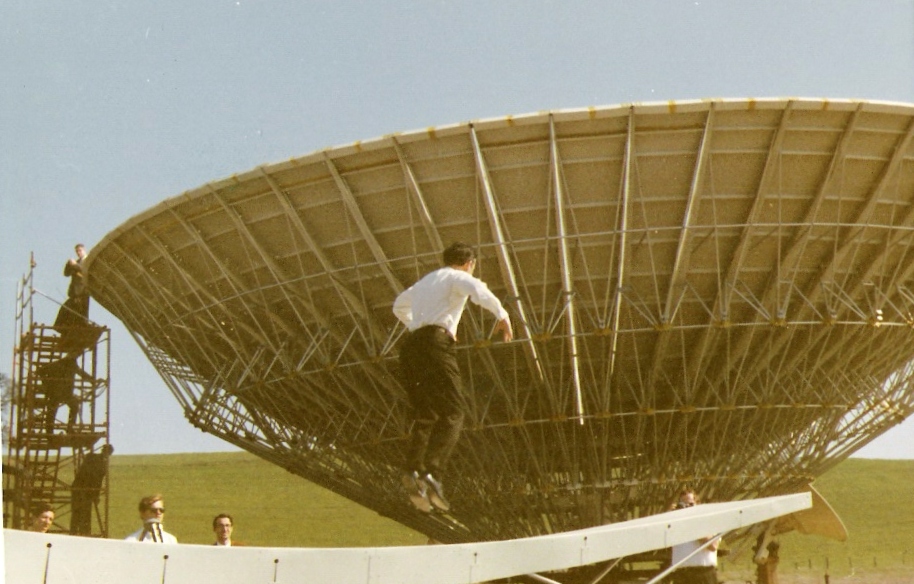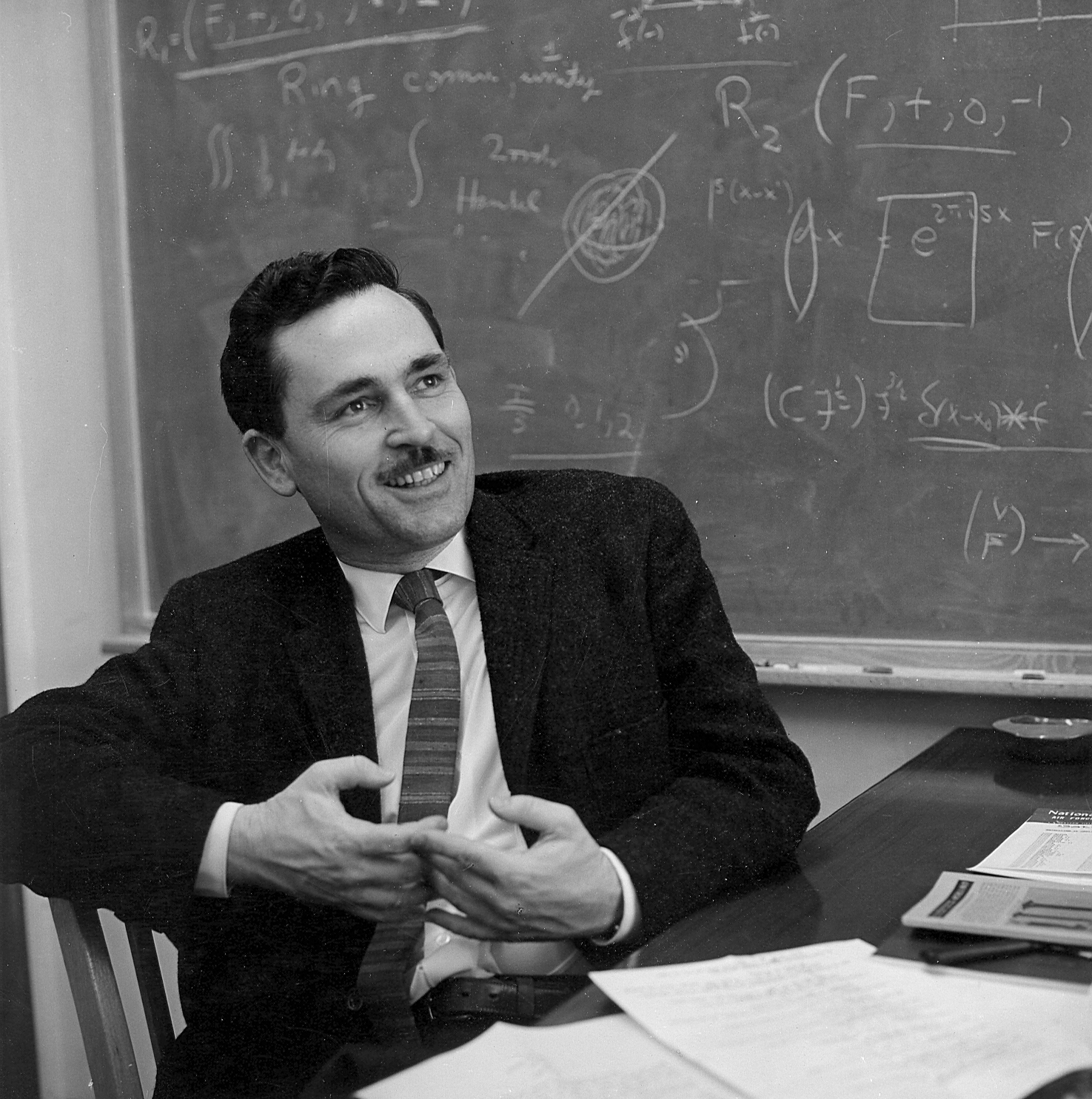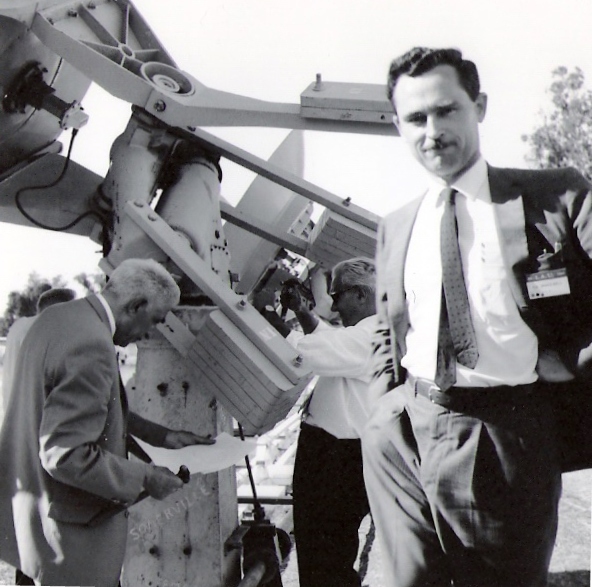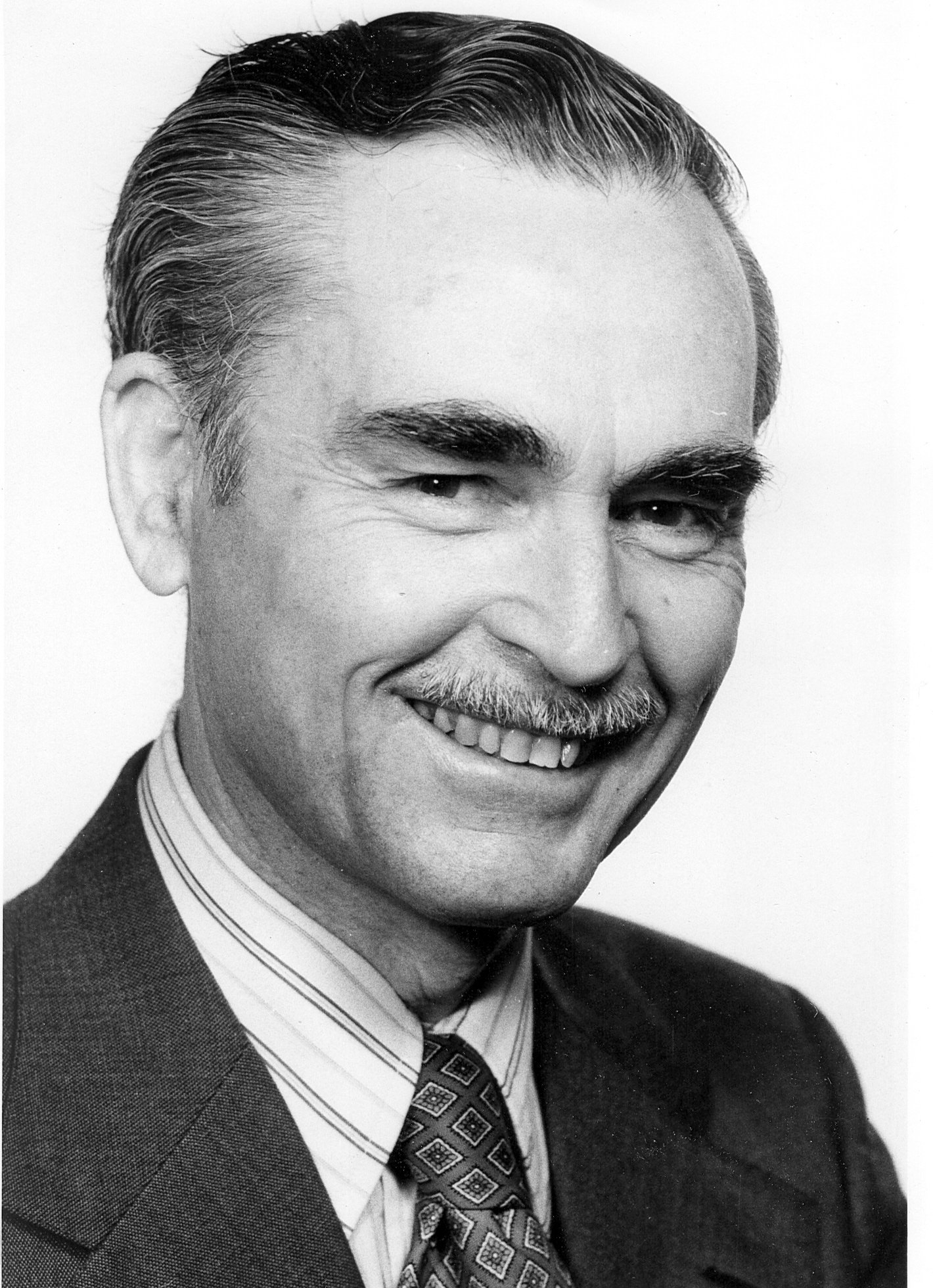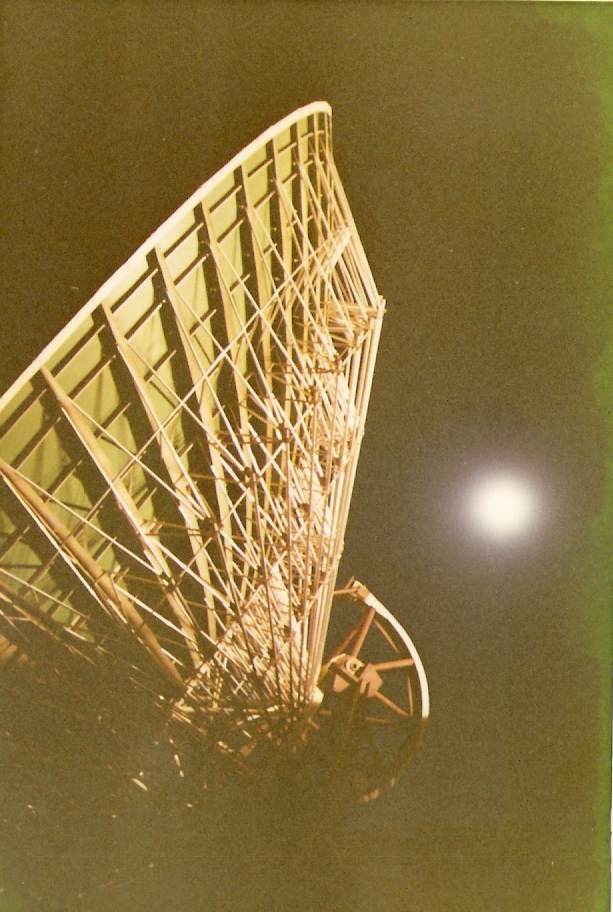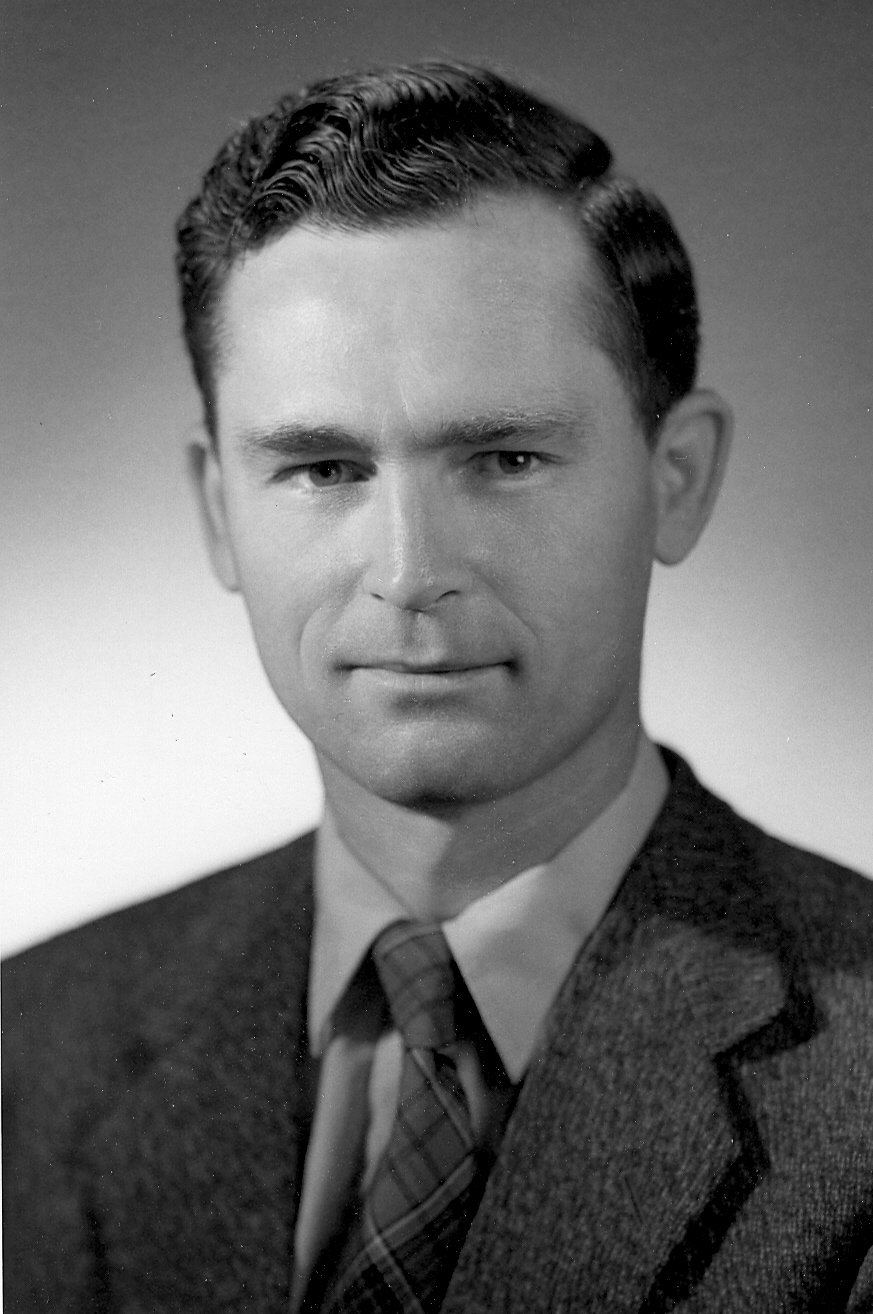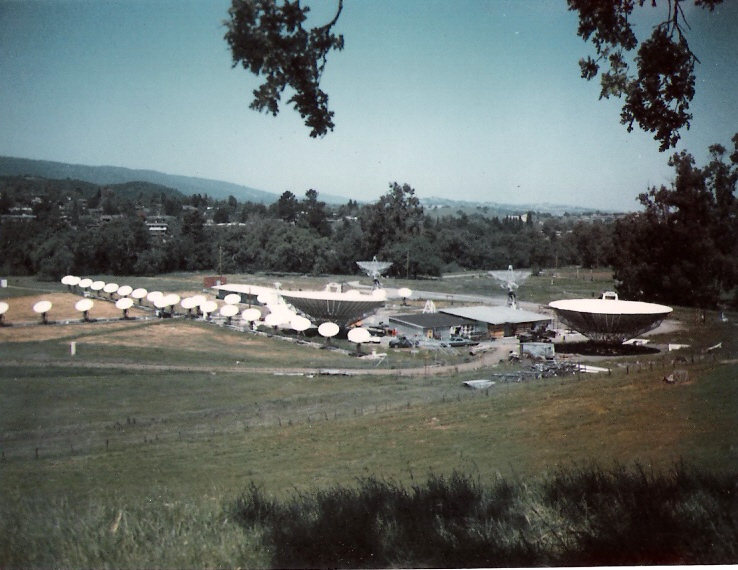| The Archives at The National Radio Astronomy Observatory is the repository for Ronald N. Bracewell's papers on radio astronomy. All other materials related to his career and activities at Stanford University are held by the Stanford University Special Collections and University Archives.
See also the complete listing of Bracewell's publications, 1942-2006.
The Papers of Woodruff T. Sullivan III include Bracewell material and a 185 minute oral interview with Bracewell conducted in 1980.
Contents:
Location of collection: National Radio Astronomy Observatory, Archives, 520 Edgemont Rd., Charlottesville, VA. Phone: 1-434-296-0203, email: archivist at nrao.edu
Title and dates of the collection: Papers of Ronald N. Bracewell, 1936-2007
Size of the collection: 63 linear feet.
Papers/Records created by: Bracewell, Ronald Newbold (1921-2007)
Short description of collection: The papers document the radio astronomy career and research of Ronald N. Bracewell, including with his doctoral work at University of Cambridge in the late 1940s, his work at Commonwealth Scientific and Industrial Organization, Australia, and his career at Stanford University. The papers include professional correspondence and papers, notes and papers on antenna design, drafts of books and professional publications, photographs, and other materials covering a period from 1936 until Bracewell's death in 2007. The Archives at The National Radio Astronomy Observatory is the repository for Ronald N. Bracewell's papers on radio astronomy. All other materials related to his career and activities at Stanford University are held by the Stanford University Special Collections and University Archives.
Top
Selected search terms:
- Ronald Newbold Bracewell, 1921-2007
- Radio astronomy - History
- Radio telescopes
- Antennas (Electronics)
- Stanford University
- Heliopolis
- Fourier analysis
- Hartley transforms
- Interferometry
- Image processing
Top
Biography: Ronald Newbold Bracewell was born in Sydney, Australia, on July 2, 1921. During the years 1933-1937 Bracewell attended the Sydney Boys High School. Languages were one of his interests, and he passed oral exams in French and German. In 1937 he was awarded the Alliance Française prize and came third in the state in French. He then attended the University of Sydney and in 1941 graduated with a degree in physics and mathematics. He continued studies in engineering and communication and received a Bachelor in Engineering degree in 1943. During the war years (1942-45) he worked at the Radiophysics Laboratory of the CSIR (Council of Scientific and Industrial Research), in Sydney, on research and development in radio communications and radar. In 1948 he received a Master of Engineering with First Class Honours from Sydney University for work done at CSIR. In 1946, when the war had ended, he went to England, to Sidney Sussex College, Cambridge, as a graduate student of J. A. Ratcliffe. He received his PhD for work on the ionosphere. Bracewell’s interest in Fourier Transforms, which was initiated by mathematics courses at Sydney University, was further stimulated by Ratcliffe who was a recognized authority on the subject. The ionospheric work resulted in the discovery that the D layer ionization consists of two components, for which Bracewell was awarded the Duddell Premium of the Institute of Electrical Engineers in 1952. The effect of solar activity on the ionosphere was one of the factors that initiated Bracewell’s lifelong interest in the sun.
When he returned from Cambridge to Australia in 1949, Bracewell initially continued his work on the ionosphere. He shared an office with radio astronomers W. N. Christiansen and H. Minnett, and became interested in their solar observations. Christiansen had built grating arrays in N-S and E-W directions along the edges of a reservoir at Potts Hill near Sydney. These produced fan-beam scans of the sun at a series of angles each day, from which it was possible to derive a two dimensional map of the sun. Bracewell was interested in this analysis and also in the possibility of using two grating arrays in a Mills cross configuration to produce a matrix of pencil beams. J. L. Pawsey, leader of the radio astronomy group, asked him to be coauthor of the book Radio Astronomy, and Bracewell surmised in retrospect that this was partly a device to get him more interested in the subject. Pawsey also asked him to produce a pictorial dictionary of Fourier transforms, which later led to his most important book, The Fourier Transform and its Applications.
Bracewell spent the academic year 1954-1955 lecturing on radio astronomy at the University of California, Berkeley, at the invitation of Otto Struve. During the summer of 1955 he lectured at Stanford University, and joined the Electrical Engineering department at Stanford in December 1955. An interesting account of this period and the initial years at Stanford can be found in Bracewell’s paper, "Early Work on Imaging Theory in Radio Astronomy," in The Early Years of Radio Astronomy, W. T. Sullivan III ed., Cambridge Univ. Press, 1984, pp. 167-190.
During the period 1949-63, from his return to CSIRO through his early years at Stanford, Bracewell produced a number of papers in the general area of interferometer theory, imaging and data analysis that established his expertise in this area. A paper on "Aerial Smoothing in Radio Astronomy" (1954) was particularly important, and explained the scanning of a source by an antenna as a convolution of the brightness function and the point-source response of the antenna. In "Strip Integration in Radio Astronomy" (1956), Bracewell considered the relationships involved in reconstructing two-dimensional images from one-dimensional scans. "Radio Interferometry of Discrete Sources" (1958) provided a precise development of the interferometer response and the Fourier transform relationship between the fringe visibility and the brightness distribution, unifying material discussed in earlier publications by various authors. "Tolerance Theory of Large Antennas" precedes by several years the famous paper on the same subject by Ruze (Proc. IEEE, 54, 633-640, 1966). Although it is difficult to be sure about precedence of ideas on this subject, which was developing during the 1950s, Bracewell’s paper is one of the earliest detailed analyses.
At Stanford, Bracewell established a radio astronomy observatory which he named Heliopolis, and he founded a Radio Astronomy Institute. The first instrument developed at Heliopolis was a crossed grating array for solar observations. The solar cross consisted of 32 parabolic antennas arranged in two linear arrays and operated at 9.1 cm wavelength. This instrument is described in "The Stanford Microwave Spectroheliograph Antenna, a Microsteradian Pencil Beam Antenna" (Bracewell and Swarup, 1961). The Stanford cross was used to make daily maps of the sun from June 1962 to August 1973, and resulted in several papers on radio emission from the solar corona. Phase adjustment of the cross led to the invention of round-trip phase measurement, which has subsequently been used in almost all large radio astronomy arrays. The round-trip technique is described by Swarup and Yang, in "Phase Adjustments of Large Antennas" (IRE Trans. AP, 9, 75-81, 1961). The east-west arm of the cross was also extended to form a compound interferometer which produced a fan beam of width 52 arcsec.
In the early 1960s Bracewell was involved in several short papers on Centaurus A, which provided a good example of a radio galaxy that was strong, optically identified, and of sufficient angular width that it could be studied in some detail with the solar cross. In April 1962, during a trip to Australia, Bracewell had the opportunity to observe Centaurus A with the Parkes telescope at 10 cm wavelength and was able to resolve the two components in the central part by driving the dish in both azimuth and elevation simultaneously so as to scan in the direction of the component separation. He was also able to rotate the feed and discover the linear polarization. However, this observation may not have been made during an officially granted observing time, and Bracewell’s letter to Nature was not published until September 29, 1962. Other observations made shortly after Bracewell’s, also reporting polarization of Centaurus A, appeared in print a few weeks before Bracewell’s letter. A more detailed account of these circumstances can be found in Explorers of the Southern Sky: A History of Australian Astronomy, by R. Haynes, D.Malin, and R. McGee, Cambridge Univ. Press, 1996, pp. 251-2.
The second major instrument developed at Heliopolis was a five-element array for galactic and extragalactic astronomy. It consisted of five 18.3 m (60 ft) diameter antennas made to Bracewell’s design at the Heliopolis site. The antennas were configured as an east-west, minimum-redundancy, linear array devised by Bracewell, in which all spacings up to nine times the unit spacing are included. The operating frequency was 10.7 GHz. The array resulted in a number of papers and theses by Bracewell’s students, including further work on Centaurus A. It was in operation from 1972 until funding for the Heliopolis observatory was discontinued in 1979, as a result of the general policy of supporting a single national observatory rather than a number of smaller ones operated by individual universities.
Another of Bracewell’s astronomical interests was the cosmic background radiation (CMB) which had been discovered in 1964. His graduate student E. K. Conklin made observations to look for variation of the background temperature, and upper limits were published in 1967. Bracewell and Conklin also calculated the variation to be expected from the motion of the earth with respect to the CMB, and in 1969 Conklin published a determination of the velocity of the Earth from measurement of variation of the observed CMB temperature at the mK level. This was the first detection of the effect, and a notable achievement considering that it was made with a simple system using two small horn antennas with an uncooled receiver. The observations were started at Heliopolis, but to achieve the sensitivity required, the later measurements were made at a high elevation site in the White Mountains of California.
About 1967, Bracewell’s work on reconstruction of images from one-dimensional scans became recognized as having an important application in tomography. This work started with his paper on "Strip Integration in Radio Astronomy" (1956), and was further advanced in the paper with graduate student A. C. Riddle on "Inversion of Fan-Beam Scans in Radio Astronomy" (1967). In this later paper the computation required is simplified by the avoidance of the need to compute Fourier transforms. Bracewell wrote two further papers specifically on tomography, one with graduate student J. Verley. He also devoted a chapter to tomography in his book Two Dimensional Imaging. For his contribution to tomography, Bracewell was awarded associate membership in the Institute of Medicine of the U.S. National Academy of Sciences in 1992.
After the closing of Heliopolis and the Radio Astronomy Institute in 1979, radio astronomical observation at Stanford was discontinued, but Bracewell’s contributions to radio astronomy and related sciences continued unabated. The use of interferometery in space for detection of nonsolar planets was suggested by Bracewell in a paper in 1978, and is discussed in six further papers extending over a number of years. These describe a proposed application of infrared interferometry in space in which a null in the fringe pattern is steered onto the position of a star to allow a search for much fainter images of planets. Although this idea remains untested it has been widely discussed as a possibility for a future space mission.
Starting in 1983, Bracewell published 16 papers and a book on mathematical development of the transform introduced by Hartley, which is similar to the Fourier transform but does not involve complex factors. He developed Hartley versions of the numerous theorems and relationships that are well known in Fourier transform theory, and also a fast Hartley transform (FHT) algorithm, which could in many cases be used as an alternative to the fast Fourier transform (FFT). The avoidance of complex quantities for transformation of real data in the FHT allowed it to perform twice as fast as the versions of the FFT in use at the time, but later improvements in the FFT have given it the advantage in speed.
During the period 1985-1989 Bracewell published a number of papers on sunspot statistics and the solar cycle. In a much earlier paper, in 1953, he had pointed out that since the magnetic polarization of sunspots changes sign in alternate 11-year sunspot cycles, the sign of the sunspot number should be reversed in alternate 11-year cycles. This reversal has the effect of removing the rectification of the activity function that is introduced by considering only the magnitude of the sunspot numbers, and results in a 22-year cycle. This important step was included in his later work in the 1980s. As part of this work he also considered the statistics of the Elatina "varves," a series of geological laminae in an area of South Australia. These had been studied by a geologist G. E. Williams who suggested that they were formed by an annual release of meltwater. The thickness of the layers showed periodic variations which could be interpreted as indicating a time scale similar to that of sunspot numbers, and the thickness was interpreted as indication of an annual variation in the strength of solar radiation. Similar structure was later found in a different region of South Australia (Sonnett et al., Nature, 335, 806-808, 1988) in which the geological situation suggested a tidal mechanism rather than a solar one. The tidal mechanism was also found to be applicable to the Elatina structure, so the solar cycle interpretation of the Elatina data became questionable. Bracewell also discovered a three-halves power law nonlinearity in the annual mean sunspot numbers, which he considered to be one of the more important results of the analysis.
Bracewell retired from teaching in 1991, but continued to be active in radio astronomy and related research projects.
Although many of Bracewell’s contributions resulted from his mathematical expertise, he can also be seen as a very able physicist in publications such as "Rotation of Artificial Earth Satellites" (with O. K.Garriot, 1958) and "An Observer Moving within the 3° K Radiation Field" (with E. K. Conklin, 1967). In a 1991 paper, Bracewell and his student D. Mihovilic introduce the concept of chirplets as a representation for ionospheric signals and similar data in a time-frequency domain. His ability as a practical engineer can be seen in the design of the antennas of the five-element array, which he was able to build for a relatively low cost. The remarkably wide range of Bracewell’s scientific interests can be clearly seen in the diversity of the subjects of his publications and lectures. Throughout his career he had a long term interest in the possibility of the existence of extraterrestrial intelligence, and the practicality of extraterrestrial communication. This resulted in 19 papers and the book The Galactic Club. An example of his interest in the history of science and engineering can be seen in the paper "Planetary Influences on Electrical Engineering" (1992). He designed sundials, one of which was installed at the Terman building on the Stanford campus. He taught for many years in Stanford’s Western Culture program in Values, Technology, Science and Society. Bracewell had a lifelong interest in trees, particularly those native to Australia, and in California he identified more than seventy species of the introduced eucalypts. He wrote two books on trees of the Stanford area and had some fine examples of banksias growing in the garden of his house at Stanford.
Some of Bracewell’s own descriptions of his work can be found in his publications "Early Work on Imaging in Radio Astronomy" (1984), "Radio Astronomy at Stanford" (2005), and the text of a recorded interview by Ragbir Bhathal on June 10, 2000, for the Oral History Section of the National Library of Australia.
During his career Bracewell published nine books and more than 200 papers. He received the Duddell Premium of the Institute of Electrical Engineers (1952), London, the Hertz Medal of the Institute of Electrical and Electronic Engineers (1994) for pioneering work in antenna aperture synthesis and image reconstruction as applied to radio astronomy and to computer-assisted tomography, and in 1998 was named to the Order of Australia for his service to science in radio astronomy and image reconstruction. For his work on imaging in tomography he was elected to Associate Membership of the Institute of Medicine of the U.S. National Academy of Sciences. From 1957-1960 he was a member of the Associated Universities Inc. Radio Astronomy Advisory Committee, renamed in 1960 as the Visiting Committee for the National Radio Astronomy Observatory. He was a Fellow of the Royal Astronomical Society (1950), Fellow and Life Member of the Institute of Electrical and Electronic Engineers (1961), Fellow of the American Association for the Advancement of Science (1989). When alumni awards were first instituted in 1992, Bracewell was one of Sydney University's three honorees, receiving a citation for brain scanning.
Bracewell married his wife Helen in 1953, and they had a son, Mark, and daughter, Wendy.
Bracewell died in Stanford on August 12, 2007.
[Biographical note written by A. Richard Thompson, with assistance from Ellen N. Bouton.]
Top
Accession history: Discussions with W. Miller Goss after Bracewell's death led to the family decision to donate Bracewell's radio astronomy papers to the National Radio Astronomy Observatory Archives. The first shipment of material, containing papers from Bracewell's departmental office, was received in May 2008. Additional material, from his home office, was received in May 2010.
Top
Access to collection: No restrictions. The Archives are open part-time; contact the Archivist for appointment.
Top
Restrictions on use of collection: None.
Top
Publication rights: Copyright for personal and research papers has been assigned to the NRAO/AUI Archives; all requests for permission to publish or quote from manuscripts must be submitted in writing to the Archivist. Copyright for Bracewell books and publications in scientific journals remains with the original publishers.
Top
Preferred citation: National Radio Astronomy Observatory/Associated Universities, Inc. Archives, Papers of Ronald N. Bracewell, <series/unit/subunit/box #>. After the initial citation, abbreviations may be used: NRAO/AUI Archives, Bracewell Papers, <series/unit/subunit/box #>.
Top
Processing notes: Initial inventory of the first shipment in this collection was done in summer 2008 by Ellen N. Bouton. Arrangement, description, indexing, foldering and boxing of the material was begun by Ellen Bouton and Evelyn Braintwain in fall 2008. Inventory and processing of a second smaller shipment, material from Bracewell's home office received in May 2010, was begun by Ellen Bouton and Evelyn Braintwain in June 2010. Dr. A. Richard Thompson, NRAO Scientist Emeritus and a friend and former Stanford colleague of Bracewell's, provided significant assistance throughout the processing of the collection. Processing was completed in May 2011. During the processing, photocopies were made to replace thermofax sheets and newspaper clippings, fasteners were removed, and materials were removed from binders of various types. Duplicates were discarded. Materials related to aspects of Bracewell's life, career, and work at Stanford outside the area of radio astronomy were sent to the Stanford University Special Collections and University Archives. Materials of a personal nature were returned to the Bracewell family.
Top
Scope and Contents of Collection
Australia and University of Cambridge Series, 1938-1956: This series includes material dated 1938-1956, including Bracewell's work at Sydney University, University of Cambridge, and at Council for Scientific and Industrial Research/Commonwealth Scientific and Industrial Research Organization, all prior to his move to the United States in 1954.
- Sydney University and Council for Scientific and Industrial Research Unit: Bracewell attended the University of Sydney and in 1941 graduated with a degree in physics and mathematics. He continued studies in engineering and communication and received a Bachelor in Engineering degree in 1943. During the war years (1942-45) he worked at the Radiophysics Laboratory of the CSIR (Council of Scientific and Industrial Research), in Sydney, on research and development in radio communications and radar. In 1948 he received a Master of Engineering with First Class Honours from Sydney University for work done at CSIR. This unit contains materials dated 1938-1948, and includes Sydney University course lecture notes, the Sydney University Engineering Undergraduates Association 1942 Yearbook, reports and instrument blueprints from CSIR, lab notebooks, and other miscellaneous materials. Bracewell's folder titles have been retained. Size: 1.25 linear feet. Click here for a listing of folders.
- University of Cambridge and Commonwealth Scientific and Industrial Research Organization Unit: In 1946 Bracewell went to England, to Sidney Sussex College, Cambridge, as a graduate student of J. A. Ratcliffe. He received his PhD for work on the ionosphere. Bracewell’s interest in Fourier Transforms, which was initiated by mathematics courses at Sydney University, was further stimulated by Ratcliffe, who was a recognized authority on the subject. The ionospheric work resulted in the discovery that the D layer ionization consists of two components, for which Bracewell was awarded the Duddell Premium of the Institute of Electrical Engineers in 1952. The effect of solar activity on the ionosphere was one of the factors that initiated Bracewell’s lifelong interest in the sun. Upon completion of his doctoral work at Cambridge, Bracewell returned in 1949 to Radiophysics in what was now called Commonwealth Scientific and Industrial Research Organization, continuing his work on the ionosphere and beginning work in radio astronomy. He left CSIRO in 1954 to lecture on radio astronomy at University of California, Berkeley. This unit contains materials dated 1946-1956, on sudden phase anomalies and sudden ionospheric disturbances, very long wavelength, and solar work, as well as lab notebooks, lecture notes, Bracewell's quarterly research reports sent to CSIR, and drafts and correspondence for papers published during the period. Bracewell's folder titles have been retained. Size: 2.5 linear feet. Click here for a listing of folders.
Top
Stanford University Series, This series includes materials on Bracewell's construction and use of radio antenna arrays at Stanford at Site 515, also known as Heliopolis, on his research, and on his consulting and contract work while at Stanford University, from 1955 until his death in 2007. Although the bulk of his Stanford correspondence is included in the Correspondence Series below, the units in this series include the correspondence Bracewell filed with these materials.
- 32 Dish Microwave Spectroheliograph and Compound Interferometer Unit: The first instrument developed at Heliopolis was a crossed grating array for solar observations, known also as the solar cross. The solar cross consisted of 32 parabolic antennas 10 feet in diameter arranged in two linear arrays and operated at 9.1 cm wavelength. The Stanford cross was used to make daily maps of the sun from June 1962 to August 1973. Materials in this unit are dated 1955-1973 and include notes, drawings, correspondence with antenna manufacturers, and blueprints. Also included are a log book for April 1969-September 1973, and laboratory notebooks kept by Roger S. Colvin and Alec G. Little on their work. Size: 0.25 linear feet plus three bound notebooks and 12 blueprints in flat file drawers. Related material: Memos on the design, construction, and operation of the instrument may be found in the Glints, see the Stanford University Publications Series below. See the Air Force Office of Scientific Research Subunit below for materials on the funding for construction and subsequent research. See the Heliopolis Demolition Unit below for materials on the demolition of the antennas.
- Solar Data Subunit: The NRAO Archives has kept a representative sample of data formats from the Spectroheliograph, including punched paper tapes, punched cards, chart recordings, a 9-track tape, plots, and several forms of computer-generated maps. Stanford Daily Maps of Solar 9.1 cm Microwave Emission for June 1962-August 1973 are archived at the National Geophysical Data Center.
- 5 Element Interferometer Unit: The second major instrument developed at Heliopolis was a five-element array for galactic and extragalactic astronomy. It consisted of five 60 foot diameter antennas made to Bracewell’s design at the Heliopolis site. The antennas were configured as an east-west, minimum-redundancy, linear array devised by Bracewell, in which all spacings up to nine times the unit spacing are included. The operating frequency was 10.7 GHz. The array was in operation from 1972 until funding for the Heliopolis observatory was discontinued in 1979. This unit includes materials dated 1963-1985. There is a folder of early notes and sketches, a copy of Bracewell's 1965 60 Foot Design notebook, Bracewell's notes for 1968-1970, material on gear procurement and on the link-belt gear reducer, a log book for November 1970-May 1985, as well as approximately 100 drawings and blueprints. Also included in this unit are a brief listing of Stanford Radio Astronomy Institute highlights and one of former Institute doctoral students, post-doc fellows, and key personnel; filed with this material is an undated handwritten document outlining the history of Heliopolis, probably written when the University wanted to demolish the dishes. Size: 0.25 linear feet plus one bound notebook and approx. 100 drawings in two flat file drawers. Related material: Memos on the design, construction, and operation of the instrument may be found in the Glints, see the Stanford University Publications Series below. See the Air Force Office of Scientific Research Subunit below for materials on the funding for construction and subsequent research. Material on the demolition of the antennas is found in the Heliopolis Demolition Unit below.
- Heliopolis Demolition Unit: The Stanford Radio Astronomy Observatory, historically known as "Heliopolis," was located at Stanford Field Site 515, and included the 32-antenna solar cross and the 5-element array. In 2004 Stanford University decided to demolish the antennas, which were no longer in active use. This unit includes correspondence, notes, photos and newspaper clippings from 2004 through 2006 regarding the proposed demolition of the antennas and the efforts to save them. Demolition was begun in March 2006. The majority of the correspondence is with Bob Lash, who helped organize Friends of the Bracewell Observatory; other correspondence is with colleagues from around the world who supported Bracewell in his fight to save the antennas. Additionally, included here is one folder from the early 1970s and one folder dated 1978-1980 containing correspondence and other materials related to early discussions about demolition of the telescopes. Size: 1.0 linear foot.
- Associates for Research in Astronomy Unit: Associates for Research in Astronomy included University of California, Berkeley, California Institute of Technology, and Stanford University, and was formed to collaborate on joint construction of a large antenna. The antenna was never built. This unit includes correspondence, notes, and reports dated 1965-1967. Size: 0.5 linear feet.
- Centaurus A Research Unit: Bracewell observed Centaurus A in March-April 1961 at Stanford. In April 1962, during a trip to Australia, he had the opportunity to observe Centaurus A with the Parkes telescope at 10 cm wavelength and was able to resolve the two components in the central part by driving the dish in both azimuth and elevation simultaneously so as to scan in the direction of the component separation. He was also able to rotate the feed and discover the linear polarization. However, this observation may not have been made during an officially granted observing time, and Bracewell’s letter to Nature was not published until September 29, 1962. Other observations made shortly after Bracewell’s, also reporting polarization of Centaurus A, appeared in print a few weeks before Bracewell’s letter. This unit includes Bracewell's 1961 Centaurus A scans from Stanford, his April 1962 notes and scans from Parkes, correspondence, research notes, and drafts for his several Centaurus A papers, collected Centaurus A reprints, and a folder of general Centaurus A correspondence. Material is dated 1956-2002. Size: 0.5 linear feet. Click here for a listing of folders.
- Sabbatical 1982 Unit: Bracewell was on sabbatical at CSIRO for the fall 1982 semester. Material in this unit is dated 1982-1983 and includes memos, correspondence, AT Memoranda written by Bracewell, a lab notebook, and a copy of Richard X. McGee's 15-page document, "Some Historical Aspects of the Division of Radiophysics," with comments by Bracewell. Size: 0.25 linear feet.
- Clamp Inflation Unit: In the early 1980s Bracewell and Kent M. Price developed a method for forming parabolic reflectors up to a few meters in diameter from flat sheets without use of a mold or template. The process involved clamping two pieces of sheet metal between two circular steel rings, then forcing the sheets apart by introducing fluid under pressure between them. The stress in the sheet metal rises beyond the elastic limit and plastic flow sets in as the assembly inflates like a balloon. When the desired amount of dishing is reached, the intake valve for the fluid is closed and the pressure is released. This unit includes correspondence, photos, drafts of a 1981 paper on the topic published in Solar Energy, technical memos on the process written by Bracewell for the Australia Telescope's AT series, as well as correspondence and other materials related to a patent application for the process. Material is dated 1979-1983. Size: 0.25 linear feet. Related material: Additional memos by Bracewell and/or Price on the clamp inflation process may be found in the Glints, see the Stanford University Publications Series below.
- Contract and Consulting Work Unit: This unit includes material on Bracewell's contract, consulting, and grant-funded work and has been divided into five subunits.
- Air Force Office of Scientific Research Contract Work Subunit: In 1955 Bracewell submitted a proposal for a microwave spectroheliograph to the Air Force Office of Scientific Research (AFOSR). Funding from 1956-1962 under contract AF 18(603)-53 resulted in the construction of the 32 element array at Stanford University Field Site 515, later called Heliopolis. Research funded under the contract included solar mapping, high angular resolution lunar observations, studies of galactic and extragalactic radio sources, and theoretical studies of high resolution antennas. The Radio Astronomy Institute at Stanford was set up in 1960 under Supplemental Agreement no. 7 to the original contract. Additional proposals and contracts supported further research projects, the construction of and research with a two element interferometer, the study for the five element array under AF 19-7249, and the construction of a five element array of 60 foot antennas. This subunit includes proposals, correspondence, reports, and other materials dated 1955-1970 related to the AFOSR contracts and work done under them. Also included in this subunit are materials related to investigation of the coherence distance of the atmosphere for microwaves, work done in 1961-1965 under contract AF 19(604)-7249 with the Air Force Cambridge Research Laboratories. Size: 1.5 linear feet. Click here for a listing of folders. Related material: See also the 32 Dish Microwave Spectroheliograph and Compound Interferometer Unit, the 5 Element Interferometer Unit, and the Heliopolis Demolition Unit above.
- National Science Foundation (NSF) Proposal Subunit: This subunit includes grant proposals to the National Science Foundation for work with both the 32-element spectroheliograph and the 5-element array. Proposals are dated 1972-1978. Size: 0.5 linear feet. Click here for an item listing.
- Office of Naval Research Contract Work Subunit: This subunit includes proposals, contracts, correspondence, and reports for work funded by the Office of Naval Research from 1972-1991, with the bulk of the material related to Bracewell's work on the Hartley transform over the period 1983-1991. Also included is a 1991 proposal on Adaptive Dynamic Spectra that was apparently not funded. Size: 0.5 linear feet. Related Materials: See the Fourier Transform and Related Topics Unit in the Subject Series below for additional material on Bracewell's Hartley transform work.
- Hughes Aircraft Company Contract Work Subunit: Material in this subunit documents the 1985-1989 relationship between Bracewell, both as an individual contractor and as a member of Stanford's Space Telecommunications And Radioscience Laboratory (STARLAB), and Hughes Aircraft Company, which formally became a STAR Affiliate in 1989. Areas of interest to Hughes included synthetic aperture radar, aperture synthesized radiometry, and images from radar scans from satellites. The subunit includes correspondence with Hughes and reports on these topics. Reprints, as well as related materials from courses taught by Bracewell, filed by him with the Hughes materials have been retained here. Some of the material is undated, but since filed here by Bracewell is presumed to be from the 1985-1989 time period. Size: 0.5 linear feet. Related material: Some of the material in the reports and many of the figures were later used by Bracewell in his 1995 book Two-Dimensional Imaging.
- Miscellaneous Contract and Consulting Work Subunit: This subunit includes material on miscellaneous proposals, contract and consulting work by Bracewell from 1958-1985. Bracewell's folder of correspondence on business aspects of the work includes correspondence, invoices, and check stubs; this material has been retained as an indicator of the wide variety of his activities not otherwise documented in the Contract and Consulting Work Unit. Size: 0.75 linear feet. Click here for a listing of folders.
Top
Correspondence Series: Researchers interested in Bracewell materials for the period 1938-1954 should see also the Australia and University of Cambridge Series, as that also includes some correspondence, but was filed separately by Bracewell; his filing arrangement has been retained. Bracewell at times used the blank back of printed sheets for his handwritten copies of his letters to others, and used such blank backs frequently when printing email; it is occasionally unclear which side of a sheet he was retaining as the relevant one. See also the other series in the Bracewell collection, as Bracewell filed much of his correspondence with relevant topical files. Correspondence in this series has been arranged chronologically, and divided into the following units:
- Official Correspondence Unit: This unit includes correspondence and notices dated 1937-1953 related to Bracewell's military service, to his appointment at CSIR, financial matters, etc. Bracewell's folder title was retained. Size: 2 folders.
- University of Cambridge Studentship Correspondence Unit: This unit includes correspondence, notes, observational notes, reports, and copies of papers submitted for publication dated 1946-1949, from Bracewell's time at Cavendish Laboratories, University of Cambridge. Also included is correspondence directly related to Bracewell's 1946 application for and receipt of a CSIR Studentship to study at Cambridge, and studentship-related correspondence and notices through his return to Australia in September 1949. Primary correspondents include E.C. Bowen, R. Bureau, L.A. d'Azambuja, M.A. Ellison, R.R. McMath, J.L. Pawsey, J.A. Ratcliffe, and M. Waldmeir. Among the topics discussed are solar flares, phase anomalies, and general information on research, procedures, and personnel at Cavendish. The majority of the correspondence is addressed to Bracewell, with a small number of copies, generally handwritten, of Bracewell's letters addressed to others. Size: 4 folders.
- CSIRO Correspondence Unit: This unit includes correspondence dated October 1949-January 1954, when Bracewell was at the Radiophysics Division of CSIRO. Includes correspondence with W.C. Bain, M.A. Ellison, J. Harwood, L.S. Prior, J.A. Ratcliffe, M. Ryle, and T.W. Straker. The majority of the correspondence is addressed to Bracewell, with a small number of copies, generally handwritten, of Bracewell's letters addressed to others. Size: 4 folders.
- Personal Correspondence Unit: This unit includes personal correspondence dated 1946-2007, with one letter dated 1944. Bracewell had organized much of the 1946-1949 correspondence into notebooks, including both originals and multiple photocopies. Where there were both originals and photocopies, originals were retained and photocopies discarded; photocopies were retained of letters for which no originals were found. Included are a photocopied set of letters written by Bracewell from the RMS Orbita en route from Australia to England, 10 August-20 September 1946, and original letters from Bracewell to his mother about his life at Cambridge, September-December 1946. Other letters dated 1946-2007 are those received by Bracewell from family and friends. In some years Bracewell designated his personal correspondence folders as sent and received, in other years he combined the correspondence chronologically; his filing arrangement has been retained. For some years in the period covered, little or no correspondence was found. Also included is one folder of notes and index listings of the 1946-1949 correspondence compiled by Bracewell. Size: 1.5 linear feet.
- Berkeley Correspondence Unit: This unit includes correspondence dated 1954-1955 when Bracewell was Visiting Assistant Professor at Berkeley for the academic year. There is correspondence regarding negotiations and arrangements for Bracewell's appointment as a Visiting Assistant Professor, and correspondence from September-December 1954 between Bracewell and colleagues, including correspondence with Joseph L. Pawsey about their forthcoming book, Radio Astronomy. Correspondence dated January-June 1955 includes Bracewell's memos to Otto Struve on plans for radio astronomy research at Berkeley, general correspondence with colleagues and family, as well as correspondence between Bracewell and Pawsey and between Bracewell and Covington about future research projects. Size: 0.25 linear feet.
- Stanford Correspondence Unit: Bracewell joined the Stanford faculty at the beginning of the 1955-1956 academic year, and remained at Stanford for the rest of his career. He retired from teaching in 1991, but continued to be active in radio astronomy and related research projects. This unit includes Bracewell's professional correspondence dated August 1955-2006. No correspondence was found in this filing sequence for 1976 or 1979, and there is only one set of letters each for July-December 1962 and for 1980. For additional correspondence, see the other series in the Bracewell collection, as Bracewell filed much of his correspondence with relevant topical files. Size: 8.0 linear feet.
- Stanford Departmental Memos Subunit: This subunit includes memos and correspondence dated 1963-1975, separated by Bracewell from other Stanford correspondence and labeled by him as "Departmental Memos." Although most items are inter- and intra-departmental correspondence, some items do not appear to differ in their format or type of content from the correspondence filed in the Stanford Correspondence Unit above. Bracewell's separation and labeling of the material has been retained. Size: 1.0 linear feet.
- Stanford Radio Astronomy Institute Chronological Correspondence Files Subunit: This subunit includes the chronological correspondence file dated 1961-1969, carbon copies of typed correspondence presumably filed by the Institute secretary. Size: 1.5 linear feet.
Top
Bracewell Publications Series: This series includes materials related to books authored or edited by Bracewell: drafts, proofs, and correspondence related to the writing and editorial process. Also included are Bracewell's Bachelor of Science and Master of Engineering degree theses, both from Sydney University, and his doctoral dissertation from University of Cambridge, and copies of most articles published in the open literature. See the complete listing of Bracewell's publications, 1942-2006.
- Theses Unit: Bracewell's Bachelor of Science in Mechanical Engineering and Master of Engineering degrees were both received from Sydney University, in 1943 and 1948. The ME degree was awarded for work Bracewell did while working at CSIR between 1942 and 1946. His doctoral dissertation work was done at University of Cambridge, and the dissertation is dated September 1949.
- Ronald N. Bracewell. Some Nomographic Methods and Their Application to Engineering Problems, November 1942. [Bachelor dissertation]
- Ronald N. Bracewell. The Theory and Application of Certain Special Types of Ultra-High Frequency Transmission Lines, January 1947 (degree awarded 1948). [Master dissertation]
- Ronald N. Bracewell. The Propagation of Very Long Radio Waves in the Ionosphere, September 1949. [Doctoral dissertation]
- Books Unit
- Radio Astronomy Subunit: Radio Astronomy, by J.L. Pawsey and R.N. Bracewell, was published by Oxford University's Clarendon Press in 1955. Pawsey, who headed the Radiophysics Laboratory at Australia's Commonwealth Scientific and Industrial Research Organization of which Bracewell was a member, asked him to be co-author, and Bracewell surmised in retrospect that this was partly a device to get him more interested in the subject. The book was one of the earliest texts on radio astronomy, which the Preface called, "a completely new branch of science." In spring 1958 Pawsey and Bracewell corresponded with Clarendon Press, considering a reprinted or revised edition, deciding to work towards a 2nd edition after the upcoming Paris Symposium on Radio Astronomy. Pawsey proposed asking J.P. Wild to collaborate on the new edition. Although some revision and rewriting was begun, the authors were all involved in other projects, and, with Pawsey's illness and death in 1962, efforts to publish another edition ended. This unit includes notes and drafts of chapter 8 ("Thermal Radio Waves from the Moon") from the original edition, 35mm negatives of original edition illustrations, along with page proofs with mark-up for the entire book. Materials relating to the proposed second edition include correspondence, an outline indicating which chapters were to be written and/or revised by Bracewell or Wild, notes and drafts for chapters 2 and 3 ("Technique for Observations of Extraterrestrial Radio Waves" and "Theory of Radio Waves in Ionized Gases"), and materials for chapters 2 and 3 returned to Bracewell by Wild in 1965. Material is dated 1951-1965. Size: 1.0 linear feet plus one filmstrip cannister.
- Paris Symposium on Radio Astronomy Subunit: The Paris Symposium on Radio Astronomy (IAU Symposium no. 9 and URSI Symposium no. 1) met in Paris from 30 July to 6 August, 1958. The proceedings were published by Stanford University Press in 1959, edited by Bracewell. A large fraction of scientists active in radio astronomy research attended the symposium, and the proceedings volume, according to Bracewell's introduction, "forms a comprehensive account of the current state of development of the basic aspects of radio astronomy." Bracewell also noted that a special feature of the book was the record of the discussion following each presentation. This subunit includes materials on preliminary planning for the symposium, correspondence on choice of publisher and the publication process, editorial correspondence with authors, copies of book reviews, original typescripts of the 107 papers presented, and discussion comments, questions, and responses handwritten by the participants. These handwritten sheets, which Bracewell had boxed separately with a label identifying them as "Paris Symposium 1958 original autograph discussion by famous radioastronomers," have been filed with the individual papers to which they refer. The typescripts of the 107 papers have been numbered to correspond with paper numbers in the proceedings volume. Material covers the period 1957-1960. Size: 1.5 linear feet.
- Steinberg and Lequeux Translation Subunit: Bracewell's English translation of Radioastronomie : les méthodes radioélectriques au service de l'astrophysique by Jean Louis Steinberg and James Lequeux, published in 1960 in France by Dunod, was published in the U.S. by McGraw-Hill in 1963. This subunit contains author and editorial correspondence related to the publication of Bracewell's translation, as well as a folder of photographs used in the volume. Principal correspondents are Ronald N. Bracewell, Jean Louis Steinberg, James Lequeux, and Charlotte Helander. Materials cover the period 1960-1964. Size: 0.25 linear feet.
- The Galactic Club Subunit: Bracewell's book, The Galactic Club: Intelligent Life in Outer Space, was published in 1974 by the Stanford Alumni Association in its series, The Portable Stanford. It was reprinted in 1976, first by the San Francisco Book Company, then by W.H. Freeman (with Charles Scribner's Sons as trade distributor), and again in 1979 by W.W. Norton. Japanese and Dutch translations were published in 1976, and an Italian translation in 1983. Contract materials list the early working title for the book as Chariots in Collision. This unit includes draft chapters and a draft manuscript, comments on chapters by colleagues, contract and literary rights materials, editorial correspondence, and reviews of the book. With The Galactic Club material, Bracewell also filed correspondence, drafts, and other materials for his related articles on SETI and intelligent life in space published in the San Francisco Examiner (1975), Horizon (1977), and Isaac Asimov's Science Fiction Magazine (1978), as well as an extensive collection of newspaper and magazine clippings on the topic. Materials are dated 1972-1978. Size: 0.75 linear feet. Click here for a listing of folders.
- Articles Unit: This unit includes single reprint copies of most Bracewell articles published in the open literature, 1947-2003. Bracewell filed drafts and correspondence related to his papers published in the open literature either in his subject files or with material from the appropriate time period, and those filing locations have been retained. Additionally, there is one folder containing copies of book reviews written by Bracewell. See the complete listing of Bracewell's publications, 1942-2006. Size: 1.0 linear feet.
Top
Stanford University Publications Series: This series includes a listing of published papers and unclassified technical reports from 1960-1973, as well as publications included in the following three units. Publications are from the Stanford Radio Astronomy Institute, the Radioscience Laboratory of the Stanford Electronics Laboratories, and the Department of Electrical Engineering. Size: 0.25 linear feet.
- Shaddows and Glints Unit: The following is an excerpt from the introduction to Glint 748, June 25, 1997, a listing of the entire series (which apparently ended at that time).
Glints are internal reports of the Stanford Radio Astronomy Institute. Any member of the Radio Astronomy group could write a Glint and hand it to the Secretary, Mildren Nilsson, and expect copies to be delivered to all members promptly, without review. Apart from providing a written record of minutiae, this custom played a role in giving students experience in succinct technical writing. Not much encouragement proved to be necessary as there was an element of compteition among graduate students not wishing to be underrepresented. Of course, the postdocs and the advanced graduate students, having had dealings with the journal refereeing system, could set good examples. Indeed, many Glints proved to be first drafts of published papers.
The first forty-nine items in the series were listed as Shaddows, the name assigned by Charles Seeger. It is not known whether this spelling had some secret significance, that Charles never clarified, or whether it was a spelling error. The first report of the series was written by James Picken on October 3, 1961. Starting with number 50, the reports were called Glints, referring to the glint in the eye of a good scientist.
As of the summer solstice 1997, the number of Glints stood at 748, representing an average production rate of 21 per annum over 36 years.
The Archives collection lacks nos. 74, 195, 479-480, 568, 600, 667-668, 670-690, 692-698, 702, 711-722, 724-736, 739-740,747. For a listing of Shaddows and Glints on which Bracewell was an author, see here. Size: 2.5 linear feet.
- Reports and Reprints Unit
- Stanford Radio Astronomy Institute Reprints Subunit: This subunit includes an index listing of the numbered reprint series, R1-R111, 1958-1981, plus a copy of individual reprints from the series retained by Bracewell in his files. Size: 0.25 linear feet.
- Stanford Radio Astronomy Institute Publications Subunit: This subunit includes individual copies retained by Bracewell in his files of Stanford Radio Astronomy Institute Publications nos. 1-19, 1958-1961. Size: 0.5 linear feet.
- Student Dissertations Unit: This unit includes dissertations submitted to the Stanford University Department of Electrical Engineering by Bracewell's doctoral students and retained by him in his files. Dissertations are by G. Swarup (1961), R.S. Colvin (1961), Z. Fazarinc (1965), S.H. Zisk (1965), A.C. Riddle (1968), G.S. Downs (1968), K.R. Lang (1969), M.P. Hughes (1970), W. Graf (1973), L.R. D'Addario (1974), S.J. Wernecke (1976), C.J. Grebenkemper (1977), J.G. Verly (1980), J.D. Villasenor (1989), D.M.W. Evans (1989), D.A. Mihovilovic (1992), and R. Nigam (1999). Size: 1.75 linear feet.
Top
Collected Publications Series: This series includes publications received by Bracewell from individuals, institutions, and corporations, as well as items collected by him. Material is dated 1966-1987 and includes primarily reprints, preprints, and reports, but also journal cuts, photostats, and newspaper clippings. Although some materials were requested by Bracewell, there are many for which it is unclear whether they were received unsolicited or were received in response to his requests. Others, such as the newspaper clippings and journal cuts, were clearly collected by Bracewell. Bracewell grouped these materials in both chronological and topical sequences, and that arrangement has been retained. The largest group of collected publications is arranged chronologically by year, and within each year is alphabetical by author. A topical group of papers on image reconstruction is arranged alphabetically by author. Preservation photocopies have been made of newspaper clippings. Reprints of Bracewell's own publications are included in the Bracewell Publications Series or the Stanford Radio Astronomy Institute Publications Series. Size: 9.0 linear feet.
Top
Conference Proceedings Series: This series includes minutes, correspondence, journal articles, notes, agendas, reports, resolutions, objectives, memos, membership applications, reprints, and charts from 1952-1985 for conferences, workshops, symposia, and meetings that Bracewell attended, including two meeting series, the 1st-6th Science Workshop on Interstellar Communication, and the 1952-1967 URSI Conferences. An extensive collection of clippings from local newspapers about the 1952 Sydney URSI meeting includes articles on Sir Edward Appleton and one on Ruby Payne-Scott. Bracewell contributions to some proceedings are included as he filed them. Size: 3.0 linear feet. Click here for a listing of folders.
Top
Subject Files Series: Bracewell kept files on a wide variety of subjects, ordered alphabetically by topic. He had two separate alphabetical sequences of subject files, as well as subject groupings not included in the sequences. All files, including the units listed below, have been merged into one alphabetical sequence using Bracewell's folder titles. Materials include reprints, preprints, notes, calculations and drawings, announcements, newspaper clippings, correspondence, and photos. Bracewell also included typescripts for and the editorial correspondence about his own papers in the subject files. Files related to aspects of Bracewell's life, career, and work at Stanford outside the area of radio astronomy were sent to the Stanford University Special Collections and University Archives. Materials in this series are dated 1938-1989. Although shelved within the series alphabetical sequence, subject units of significent size or special interest are described as separate units. Inclusive series size: 14 linear feet, plus 1 drop front box, 18.5"x14.75"x3". Click here for a listing of folders (see below for folder listings for separate units).
- Annual Reviews Article Unit: Bracewell's article on Computer Image Processing appeared in Annual Reviews of Astronomy and Astrophysics, vol. 17, 1979. This unit includes editorial correspondence, notes, and reprints collected by Bracewell during his research. Material is dated 1973-1979. Size: 4 folders.
- Arecibo Advisory Board Unit: Notes, correspondence, reports, and meeting minutes for the period 1970-1976 related to Bracewell's tenure on the Arecibo Advisory Board. Also included is a set of "Week at Arecibo" dated 11 December 1972 through 23 June 1974. Size: 0.5 linear feet.
- Fourier Transform and Related Topics Unit: Bracewell published, The Fourier Transform and Its Applications in 1965, and the book's 2nd and 3rd editions appeared in 1978 and 2000. Beginning in 1983, he published 16 papers and a book, The Hartley Transform, on mathematical development of the transform introduced by Hartley, which is similar to the Fourier transform but does not involve complex factors. This unit includes notes, papers, correspondence, reprints, patent applications, and other materials on the Fourier, Hartley, and other transforms. Material is dated 1964-1998. Size: 1.5 linear feet. Click here for a listing of folders. Related Materials: See the Office of Naval Research Contract Work Subunit in the Stanford University Series above for additional material on Bracewell's Hartley transform work.
- Galaxy, Life in Unit: Bracewell used the heading "Galaxy, Life in" for his files on extraterrestrial life, interstellar communication, space probes, and related topics. Included are preprints and reprints, newspaper articles, outlines of radio programs, and notes for radio talks. Typescripts and drafts, some handwritten, of published papers and lectures by Bracewell on topics related to life in the galaxy are included. Correspondence from 1960-1964 responding to Bracewell's 1960 article in the weekly Sunday news magazine, This Week, is primarily from the general public but includes some letters from professional colleagues. Also included are the Bibliography of Exobiology, and several editions of the Bibliography of Interstellar Flight and its later title, Bibliography of Interstellar Travel and Communication. Reprint authors include Claude W. Anderson, Frank Drake, Freeman J. Dyson, H. Pierre Noyes, Gerard K. O'Neill, Carl Sagan, I.S. Shklovsky, W.T. Sullivan III, Sebastian Von Hoerner, and others. See also related subject file materials under Lunan, Duncan. Inclusive dates are 1959-1980. Size: 1.0 linear feet. Click here for a listing of folders. Related materials: See also the Records of the National Radio Astronomy Observatory, the Papers of John D. Kraus, and the Conferences and Lectures listing in the Papers of Woodruff T. Sullivan III..
- Infrared Interferometry Unit: This unit includes correspondence, notes (including some on paper placemats), reports, and collected reprints from 31 August 1976 through 14 February 1996 regarding Bracewell’s study of infrared interferometry. Robert H. McPhie of Waterloo University worked with Bracewell at Stanford from 1977 through 1978, and the unit includes correspondence with and materials from McPhie. Size: 8 folders.
- Maximum Entropy and Clean Unit: Reprints, preprints, photocopied journal articles, notes, and correspondence for the period 1970-1994. Size: 4 folders.
- Moon Unit: Included are Bracewell's 1959 "Proposal for studying the moon by microwave radar with high angular resolution," bid requests and bids for equipment needed for the proposed experiment, correspondence, and photographs. Material is dated 1959-1960. Size: 4 folders. Click here for a listing of folders.
- National Science Foundation, Advisory Panel for Radio Astronomy Unit: Notes, correspondence, and meeting minutes for the period 1961-1964 related to Bracewell's tenure on the Advisory Panel. Size: 1 folder.
- Pierce Committee Unit: Notes, correspondence, and meeting minutes for the period 1959-1961 leading to the Report of the Advisory Panel on Radio Telescopes. A copy of the final report as published in Astrophysical Journal, vol. 134, November 1961, is included. The Panel, appointed by the National Science Foundation, was asked to study existing and proposed instruments and radio astronomers' needs, and advise NSF on the desirability and feasibility of constructing more powerful instruments. Bracewell was a member of the Panel chaired by J.R. Pierce. Correspondents include John G. Bolton, Ronald N. Bracewell, William E. Gordon, Geoffrey Keller, R. Minkowski, J.R. Pierce, Grote Reber, Otto Struve, and George W. Swenson, Jr. Size: 2 folders.
- Pulsars Unit: Primarily reprints, 1965-1972. One folder of notes and calculations, 1968, Size: 0.5 linear feet.
- Radio Noise Maps Unit: In 1957 Donald H. Menzel produced a set of radio noise maps under a contract between Harvard University and the Dept. of the Army, Signal Corps Procurement Office. These maps were specially designed charts in the form of a planisphere, with transparent sky maps of levels of radio noise which rotate over a grid representing the various altitudes and bearings in the visible sky at the observer's latitude. Bracewell acted as a consultant to Menzel's project. This unit includes the radio noise map set. Size: 1 drop front box, 18.5"x14.75"x3".
- Rainfall Experiments Unit: Correspondence, notes, reports, data records, and charts on rainfall experiments and freezing nucleus research from 1953-1976. Principal correspondents are E.K. (Taffy) Bowen and Ronald N. Bracewell. Size: 4 folders.
- Solar Unit: Correspondence, notes, meeting programs, reports, data records, draft manuscripts of published and unpublished papers on solar topics, including sunspots, solar rotation, solar quiescent prominences, solar microwave emission, and solar proposals to the National Science Foundation. Material is dated 1952-2006. Size: 1.0 linear feet. Click here for a listing of folders.
- Collected Solar Reprints Subunit: This subunit includes reprints from 1948 through 2001, with one reprint from 1927, which were collected by Bracewell. The reprints are filed in alphabetical order by author. Also included are two additional topical solar reprints folders compiled and labeled by Bracewell: Filaments (1962-1980) and S-component (1959-1974). Size: 1.5 linear feet.
- URSI Unit: This unit includes URSI Commission 5 correspondence, membership applications, and reports from 1962-1976. Size: 3 folders. Related material: For material on specific URSI meetings, see the Conference Proceedings Series above.
- Varves Unit: As part of his work on solar cycles, Bracewell considered the statistics of the Elatina "varves," a series of geological laminae in an area of South Australia. These had been studied by a geologist G. E. Williams who suggested that they were formed by an annual release of meltwater. The thickness of the layers showed periodic variations which could be interpreted as indicating a time scale similar to that of sunspot numbers, and the thickness was interpreted as indication of an annual variation in the strength of solar radiation. Similar structure was later found in a different region of South Australia in which the geological situation suggested a tidal mechanism rather than a solar one. The tidal mechanism was also found to be applicable to the Elatina structure, so the solar cycle interpretation of the Elatina data became questionable. Material in this unit is dated 1946-1995, and includes reprints, correspondence, notes, drawings, diagrams, photos, slides, negatives, transparencies, journal cuts, newspaper clippings, collected reprints, and lectures. Bracewell’s original arrangement of the collection, as well as most of his folder titles, have been retained. Size: 0.75 linear feet. Click here for a listing of folders.
- Whitford Committee Unit: In late 1962 the National Academy of Sciences, Committee on Science and Public Policy, established the Panel on Astronomical Facilities, chaired by Albert E. Whitford. The Panel was charged with studying the needs for major new ground-based astronomical facilities in the United States over the next five to ten years, and with recommending principles and costs to guide the use of federal funds to promote advancement in U.S. astronomy. Bracewell was a member of the Panel. The Panel first met in January 1963 and their formal report, Ground-Based Astronomy: A Ten-Year Program, was published in autumn 1964. This unit includes notes, correspondence, recommendations to the Panel from members of the astronomical community, meeting minutes, and draft reports dated 1962-1965. Size: 1 folder.
Top
Photographs and Moving Images Series: This series includes photographs and moving images collected by Bracewell, and has been divided into two units.
- Photographs Unit: This unit contains photographs, slides, negatives, postcards, a bookmark, CD, DVD, and filmstrip dated 1926-2006. Subject matter includes Bracewell’s arrays at Stanford, other radio telescopes, astronomical images, CSIRO Radiophysics and Sydney University, family, people, groups and conferences, and Halley’s Comet Expedition. A selection of photos have been digitized. Size: 2.25 linear feet. Click here for a listing of folders and digital photos.
- Moving Images Unit: Contact archivist for details.
Top
Miscellany Series: This series contains miscellaneous materials dated 1936-2005. Size: 0.25 linear feet. Click here for a listing of folders.
Top
Additional Materials about Bracewell Series: These materials are about Bracewell but were not created or collected by him. Included are obituaries and other biographical materials, correspondence about Bracewell or his work, a copy of an April 1975 newspaper clipping about the ending of Stanford's radio astronomy program, as well as copies of 1949 correspondence from the National Archives of Australia (C3830 A1/1/1 part 4 1949), and the transcript of a 10 June 2000 oral history interview of Bracewell by Ragbir Bhathal of the National Library of Australia. Material from National Archives of Australia and from the National Library of Australia may not be copied, and permission to quote must be obtained from them. Size: 0.25 linear feet. See also materials about Bracewell in the Miscellany Series of the Papers of A. Richard Thompson.
- Bracewell Sundial at the VLA Unit: The Ronald N. Bracewell Radio Sundial at the National Radio Astronomy Observatory's VLA site outside Socorro, New Mexico, incorporates concrete piers that originally held antennas for Bracewell's 32 Dish Microwave Spectroheliograph at Stanford University (see the 32 Dish Microwave Spectroheliograph and Compound Interferometer Unit above). Over a 20-year period, Bracewell accumulated 250 or more "signatures" chiseled into the piers. Those who "signed" his piers included two Nobel Prize recipients, directors of observatories, both radio and optical, from around the world, and many of the early pioneers of radio astronomy who established the field in the years following World War II. Bracewell's interferometer was abandoned in 1980. In 2012, ten of the concrete piers were sawed off and transported to the VLA to become part of the sundial. The piers in the sundial have approximately 220 signatures, including some in Chinese, Russian, and Greek. The sundial was designed by Dr. Woodruff T. Sullivan III of the University of Washington and was opened on the Autumn Equinox of 2013. The historic piers and one dish were donated to the National Radio Astronomy Observatory (NRAO) for this purpose by Stanford University. Funding for preparing and transporting the piers and for creating the sundial was provided by Friends of the Bracewell Observatory Association, Associated Universities, Inc., and the National Science Foundation. NRAO Project Lead: Dr. Miller Goss; Project Engineer: Guy Stanzione; Project Coordinator: Judy Stanley. This unit includes photographs, listings of signatures, biographical information on selected signers, and other materials related to the sundial design, fabrication, and installation. Dated 2013-2019. Click here for digitized material in this unit.
- Bracewell Sundial 10th Anniversary Subunit: The 10th anniversary celebration for the Bracewell Sundial was held on 28 September 2023. Click here for the program and photos of the event.
|
